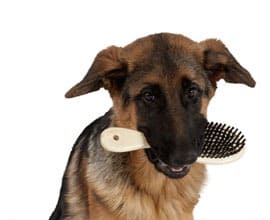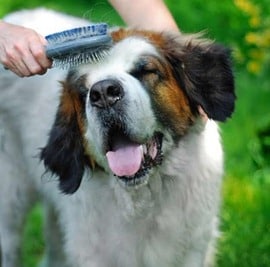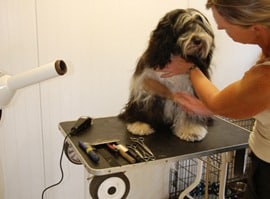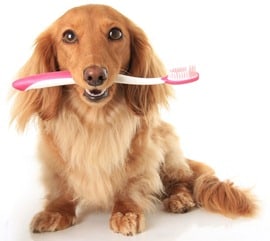Grooming a dog and brushing his teeth is rarely an easy task. If you haven’t done the work while he was still a pup, chances are that he will not be used to standing still long enough to allow you to finish the job. That’s why you should get your puppy used to grooming and sitting still, allowing you to brush his teeth and groom him, even though he might not need it when he’s a pup. Keep reading and check out our list of ten tips on how to do grooming on your dog.
1. Just Do It
Since you can’t groom a moving dog, train Snowflake from the moment she moves in to sit still while you brush her – when she’s just a pup, be extra gentle, as your main concern them will be conditioning her to the process more than taking care of any serious hygiene issues. Groom her every day if she is long-haired, and at least three or four times a week otherwise. And train your puppy now to sit and stand in the same place you’d like her to be when she’s full-grown. That will save your back later on!
2. Use the Right Technique

Use a slip-proof mat for her to stand on, and hold her gently by the collar while you are brushing: these will help her feel safe. Start near the paw of one of her front legs so she can see what you are doing, and work your way up the leg. Make sure your brush follows the natural direction of the fur, and that each section is completely brushed or combed out before you move on. Praise her often for cooperating – she should come to see this grooming as another chance for your undivided attention – and don’t let her squirm or play with the brushes.
3. Use the Right Tools
Choosing the proper brush or comb for the job depends on the particular dog. For a puppy, use a very soft bristle brush or even a regular dry washcloth, just to get him accustomed to your touch. Bristle brushes are also good for short-haired breeds: the most popular ones are a combination of nylon and natural bristles, or all-natural brushes. (Shedding and grooming gloves also work well for short hair.) Bristle brushes are perfect for sensitive spots such as your dog’s head and ears, or areas that might be tender for any reason.
For long-haired dogs, you will need a pin brush – these have metal “bristles,” with or without acrylic tips – or a slicker brush. The slicker brush also has metal bristles, but they are very fine and closer together; properly used they are excellent at helping with mats and tangles.
You can use shedding blades on any breed. These are serrated metal bands that look rather frightening but are actually harmless when used properly – that is, as long as you don’t press hard enough that the teeth dig into Snowflake’s tender skin! – and are very effective at removing dander and shedding fur. Most have a coarse and a fine side. Combs, on the other hand, should only be used on breeds with fine coats, and only after you have removed any mats or tangles; otherwise, even the combs with widely spaced tines can cause painful pulls.
4. Take Care of Problems Early

5. Bathe Your Dog Occasionally
Most dogs do not need frequent baths. Dedicated dog shampoos and conditioners have made it less harmful to the dog’s skin and fur, but without these specially formulated (and often expensive) products, you can end up stripping the protective oils found naturally in the dog’s skin. She may smell “pretty,” but she may also be itchy and miserable. The average dog should not need a bath more than every two or three months, but follow your nose: if Snowflake has been wallowing in dead fish, don’t worry that she just had a bath last week – just clean her up. But use as little shampoo as necessary, and make sure it’s one made for dogs, not humans.
Even dogs that love the water swim aren’t born loving baths. As with all grooming practices, you should get Snowflake used to the tub while she’s still young – usually around five or six months is about right for the first bath – so you won’t be chasing her around when she’s full-grown. For small dogs you can use your sink (don’t forget a strainer on the drain, though, to catch the dog hair); for larger dogs use your bathtub or a special raised pet bathtub. Outdoor hoses are not ideal since the water is often very cold.
Make sure you’ve completely brushed Snowflake before bathing her to remove all the loose hair. If you have it, apply ophthalmic ointment (one made for dogs) to protect her eyes from soap stings, and tuck a cotton ball into her ears (not too far!) to help keep water out. A hose that attaches to the faucet is ideal. Start at the head and work your way back in case Snowflake has fleas: that way, you chase them away from her eyes and face. Don’t spray water directly in her face – a washcloth works well for the head and ears. Wet her down first with lukewarm water, then lather her up, massaging it into her coat, working from the neck down. Make sure you clean everywhere, including her groin area (but don’t spray the genitals directly or scrub too hard). Rinse thoroughly and, optionally, apply doggy conditioner (you might mix it in with the rinse water). Dry her well with a towel. For long-haired dogs especially, considering blow-drying her on the warm (not hot) setting; in any case, long-haired breeds should be combed out after a bath. Keep Snowflake inside until she’s completely dry, or she’ll come back inside looking as though she never had that bath. Most important: talk to her and praise her from beginning to end.
6. Teach Your Dog to Accept “Approved” Strangers

7. Special Circumstances
Dogs love to roll in all sorts of foul smelling things like garbage and dead fish. Experts theorize that they do this to disguise their natural scent, the better to sneak up on prey. Since Snowflake does not need to sneak up her kibble to survive, you will not be endangering her life by preventing her from getting smelly while she’s on the leash. Should she manage to find a pile of something disgusting all on her own, at least train her that she will not get petted, treated or let into the house until after she’s had a bath.
What if Snowflake tangles with a skunk? First, if she got it in the face, rinse her eyes completely. Second, do not let her into your house or car, or you will live with the smell for weeks, even after she’s smelling better. Third, try washing her with one of these frequently suggested concoctions: (1) 1 quart 3% hydrogen peroxide, ¼ cup baking soda, 1 teaspoon of liquid soap, mixed in a large container (since it will bubble up); (2) 1 cup vinegar, 1 cup 3% hydrogen peroxide, 1 cup dish soap, then rinse with ½ cup vinegar in 1 gallon of water; (3) 1 pint 3% hydrogen peroxide, 2/3 cup baking soda, 1 teaspoon liquid soap (citrus); (4) tomato juice; or (5) a commercially prepared skunk/odor remover. Good luck!
8. Spot-Check Spot
Grooming time is the perfect time to inspect every part of your dog for fleas, tickets, cuts, scrapes, lumps and anything else that might be hiding under all that hair. Make sure that in addition to brushing her you run your hands all over her, too, feeling for anything that doesn’t belong there. She’ll love it, too.
9. Shine Those Canines

10. Clip Her Nails
If Snowflake spends a lot of time trotting along the sidewalk, you may not need to trim her nails. But most dogs need a trim now and then to keep their gait natural and to prevent any ingrown nails. There are many different types of nail trimmers available, but regardless of which type you choose, remember that you only want to remove the very tip. Check your Snowflake’s nails to see if there is at least one that is white or clear. If so, you should notice a pinkish part extending out from the nail-bed toward the tip: this pink part is the “quick,” and cutting into it will cause pain and bleeding. Use this nail as a guide for the others. If all your dog’s nails are dark, play it safe and just clip the very end – the sharp part that hooks (and goes ticka-ticka-ticka on the floor).
